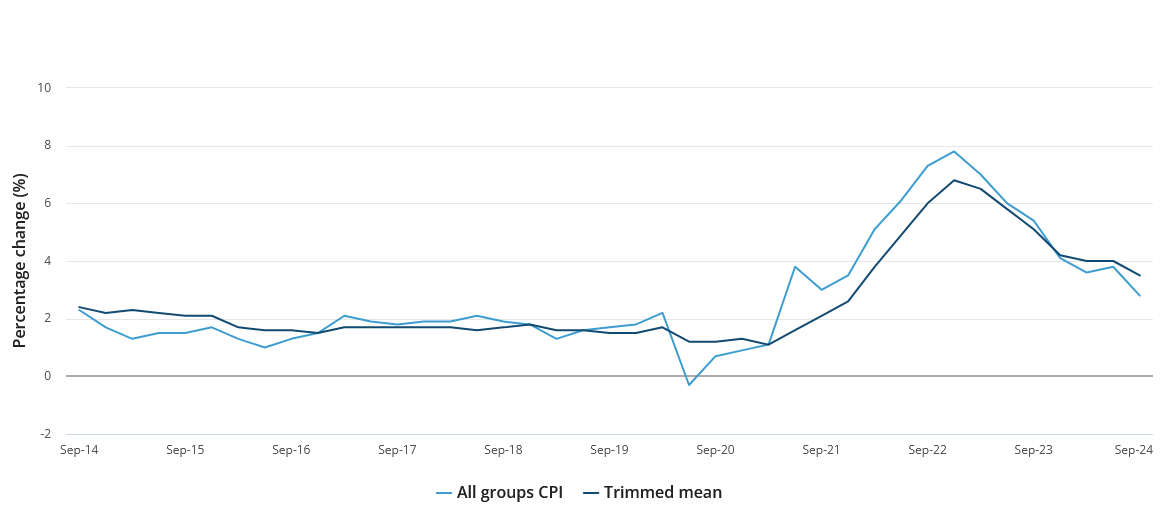But not enough for earlier interest rate cut, says ANZ

In a positive sign for Australia’s economy and millions of mortgage-holders desperate for interest rate cuts, inflation has fallen to 2.8% for the September 2024 quarter, within the Reserve Bank of Australia’s 2% to 3% target range.
Consumer price index figures released on Wednesday, October 30, by the Australian Bureau of Statistics, show CPI – the key inflation indicator – rose just 0.2% for the September quarter and 2.8% annually.
ABS head of prices statistics Michelle Marquardt (pictured above left), said the 0.2% rise was the lowest outcome since the June 2020 quarter fall which occurred during the COVID-19 outbreak and was driven by free childcare.
“Annually, the September quarter’s rise of 2.8% was down from 3.8% in the June quarter,” Marquardt said. “This is the lowest annual inflation rate since the March 2021 quarter.”
The ABS reported on its website that while prices continued to rise for most goods and services, the increases were offset by large falls for power and fuel prices.
However, ANZ does not think the reduction in inflation will be enough to prompt the RBA to cut interest rates this year.
Trimmed mean inflation also down
A measure of underlying inflation, annual trimmed mean inflation excludes volatile price movements and provides additional insights into how inflation is trending.
The ABS reported trimmed mean annual inflation was 3.5%, down from 4.0% in the June quarter.
“The trimmed mean excluded the significant falls in both electricity and automotive fuel this quarter, alongside other large price rises and falls. As a result, trimmed mean annual inflation of 3.5% was higher than CPI inflation of 2.8%,” Marquardt said.
ANZ’s view of latest CPI figures
Reacting to the latest ABS figures, senior ANZ economist Catherine Birch (pictured above right) said trimmed mean inflation of 3.5% was in line with the expectations of the bank, the RBA and the market.
“The six-month annualised rate of trimmed mean inflation decreased 0.5ppt to 3.3% (a little above the 2-3% target,” Birch said. “Services inflation ticked up for a second consecutive quarter to 4.6% year on year.”
“We do not think the decline in trimmed mean inflation will be enough to convince the RBA it should begin the easing cycle this year, particularly as there does not appear to be an urgent need to support the labour market, given its resilience over recent months.”
Birch said ANZ maintained its call for the RBA to hold the cash rate at 4.35% until a 25bp cut in February 2025, with underlying inflation expected to ease a little further in Q4 2024.
“Should inflation not ease as we expect and/or the labour market and activity data show more resilience, easing could be delayed.”
All groups CPI and trimmed mean inflation, annual movement (%)

Source: Australian Bureau of Statistics, September 2024 quarter CPI
Factors affecting quarterly inflation
Recreation and culture, up 1.3% and food and non-alcoholic beverages (+0.6%) were the largest contributors to the September quarterly inflation rise of 0.2%.
Marquardt said price rises for other goods and services were largely offset by falls in electricity (-17.3%) and automotive fuel prices (-6.7%).
“The 2024-25 Commonwealth Energy Bill Relief Fund rebates in all states and territories and state government electricity rebates in Queensland, Western Australia and Tasmania led to a large fall in electricity prices this quarter. Without the rebates, electricity prices would have increased 0.7% this quarter,” she said.
Lower global demand reduced the price of oil, which meant petrol prices fell in each of the past three months to reach their lowest level since the June 2023 quarter.
Marquardt said the quarterly growth in recreation and culture was driven by international holiday travel and accommodation (+1.9%) and domestic holiday travel and accommodation (+1.1 %).
“Higher demand for international tours and accommodation, particularly in Europe where it was peak travel season, led to price increases. The school holiday period contributed to increases in domestic accommodation prices.”
An uplift in food and non-alcoholic beverage prices was driven by meals out and takeaway food (+0.8%), meat and seafood (+1.1%), and fruit and vegetables (+1%).
Annual inflation
CPI rose 2.8% annually, a large drop from 3.8% last quarter. The ABS said the main contributors to the slowing of annual inflation were again the large drops in electricity and fuel prices.
Marquardt said annual goods inflation was 1.4%, driven by price rises for new dwellings and tobacco. The decline in annual goods inflation from 3.2% in the previous quarter was also due to the significant falls in power and petrol prices.
Annual services inflation was 4.6% in the September quarter, up from 4.5% in the previous quarter, driven by higher prices for rents, insurance and childcare.
RBA’s next move
The million-dollar question is now whether the September quarterly inflation figure of 2.8%, which is in the RBA’s target inflation range, will prompt the central bank to lower the cash rate earlier than commentators have forecast.
NAB predicts the Reserve Bank will start cutting interest rates in February 2025, a view shared by major banks ANZ and Westpac, while Commonwealth Bank is more bullish, predicting the first cash rate cut will arrive in December 2024.
The minutes released from the RBA Board’s meeting on September 23 and 24, in which it decided to keep the official cash rate on hold at 4.35%, said a key question was how spending was evolving in the September quarter.
“The staff had previously forecast household consumption to strengthen in response to a recovery in real incomes, including because of the implementation of the Stage 3 tax cuts in July,” the RBA’s minutes stated.
Retailers in the RBA’s liaison program had reported that conditions had remained stable over prior months and were generally expected to stay that way over coming months.
Based on this information, RBA board judged that it was still reasonable to expect a pick-up in consumption growth over the second half of the year, but it was too soon to form firm views based on these partial indicators and “there was some risk that the pick-up could be somewhat slower than previously expected” .
Now that the September quarter inflation figures have been released, showing a fall of 100 basis points since the July quarter as well as trimmed mean inflation falling 0.5%, the RBA will take this account when the board meets on Tuesday, November 5, to make a decision on the cash rate.
It’s highly unlikely that the RBA will cut the rate at its November meeting but if the inflation figures continue to improve, economists might change their predictions about the timings for cuts in 2025.



